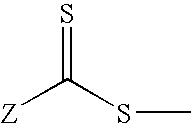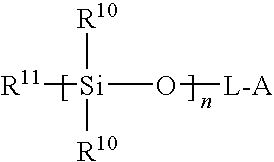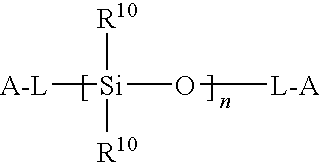Biomedical devices
a biomedical device and biotechnology, applied in the field of biomedical devices, can solve the problems of affecting eye movement and comfort, affecting eye movement, and unable to comfortably wear the eyewear, etc., and achieves the effects of reducing modulus, high oxygen permeability, and high comfor
- Summary
- Abstract
- Description
- Claims
- Application Information
AI Technical Summary
Benefits of technology
Problems solved by technology
Method used
Image
Examples
example 1
[0098]Preparation of Multifunctional Ester-Based PDMS RAFT Homopolymer (4).
[0099]Oxalyl chloride (5.0 mL, mmol) was added while stirring to S,S′-bis(α,α′-dimethyl-α″-acetic acid)trithiocarbonate 1 (1.0 g, 3.6 mmoL) kept under nitrogen at room temperature. At the end of the addition, the resulting heterogeneous mixture was warmed up to 60° C. for 3 hours, resulting in the formation of a bright yellow solution. The excess oxalyl chloride was evaporated under reduced pressure to yield 1.05 g of S,S′-bis(α,α′-dimethyl-α″-acetyl chloride)trithiocarbonate as a white solid.
[0100]Acetyl chloride was dissolved in dry methylene chloride (50 mL) and added dropwise into a solution of hydroxylpropyl terminated PDMS diol (6.77 g, 3.22 mmol) in 200 mL of anhydrous methylene chloride with vigorous stirring at 0C. After the reaction mixture was stirred for 24 hours at room temperature, the solvent was removed under reduced pressure to give 6.59 g of yellow viscous oil, which was eluted through a sho...
example 2
[0101]Preparation of Multifunctional Amide-Based PDMS RAFT Homopolymer (6).
[0102]In a three-neck round bottom flask 8.52 g (3.4 mmoL) of PDMS precursor was dissolved in methylene chloride (150 mL). Triethylamine (1.43 g, 14.2 mmoL) was added, and the solution was cooled in an ice-water bath. In the meantime, oxalyl chloride (6 mL) was added to another one-neck round bottom flask containing 1.0 g (3.6 mmoL) of trithiocarbonate diacid (1). After stirring at 60° C. for 2 hours, the excess oxalyl chloride is evaporated under reduced pressure. The remains were dissolved in 50 mL dry methylene chloride and added dropwise to the PDMS diamine solution with vigorous stirring. The reaction mixture was stirred for 18 hour at room temperature. The solvent was removed by vacuum and the yellow oil obtained was filtered through short plug of silica-gel (eluens: CH2Cl2 / MeOH 3:1). Evaporation of the combined fractions afforded 7.92 g of multifunctional amide-based PDMS RAFT macromonomer (6). The rea...
example 3
[0103]Preparation of Difunctional Ester-Based PDMS RAFT Homopolymer (9).
[0104]Oxalyl chloride was added to RAFT-CTA (2) (2.05 g, 5.6 mmoL) at room temperature with rapid stirring, and under a nitrogen atmosphere. After 4 hours of stirring, the evolution of gases had ceased and the reaction was homogenous. The excess oxalyl chloride was removed under reduced pressure to yield acyl chloride (10) (2.1 g), which was dissolved in 20 mL of anhydrous methylene chloride. This solution was gradually added dropwise into a solution of PDMS diol 3 (4.48 g, 2.2 mmoL) in 80 mL of anhydrous methylene chloride. The reaction mixture was stirred for 14 hours at room temperature. At the end of the reaction, methanol (2 mL) was added to quench the remaining acyl chloride. The. solvents were removed under reduced pressure to give 6.50 g of reddish oil, which was eluted through a silica gel column using methylene chloride / hexane (gradient elution 5→50 v / v % CHCl2 / hexane) as eluent to separate the difunct...
PUM
| Property | Measurement | Unit |
|---|---|---|
| weight percent | aaaaa | aaaaa |
| weight percent | aaaaa | aaaaa |
| hydrophilic | aaaaa | aaaaa |
Abstract
Description
Claims
Application Information
 Login to View More
Login to View More - R&D
- Intellectual Property
- Life Sciences
- Materials
- Tech Scout
- Unparalleled Data Quality
- Higher Quality Content
- 60% Fewer Hallucinations
Browse by: Latest US Patents, China's latest patents, Technical Efficacy Thesaurus, Application Domain, Technology Topic, Popular Technical Reports.
© 2025 PatSnap. All rights reserved.Legal|Privacy policy|Modern Slavery Act Transparency Statement|Sitemap|About US| Contact US: help@patsnap.com



